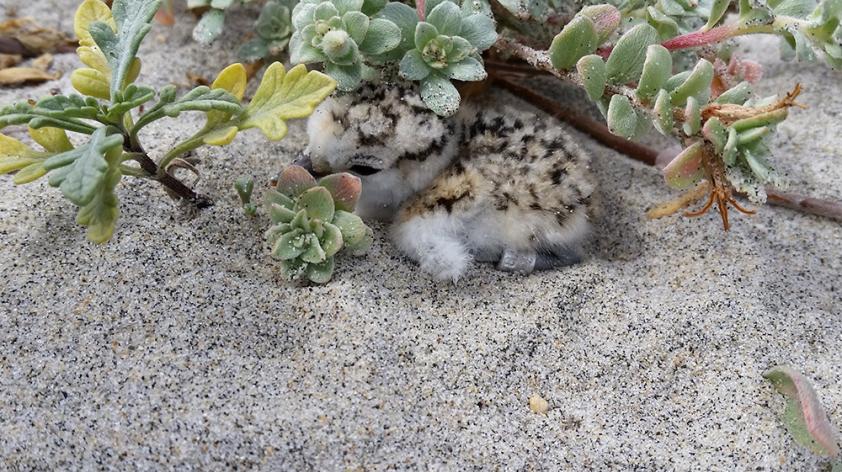
Plover Hide and Seek
A snowy plover chick's cryptic coloration provides excellent camouflage.
Well it’s finally here, SUMMER! As a born-and-raised San Diegan, I know that one thing is for certain this time of year: the beaches become a popular place to visit for some fun in the sun. Besides having to share the sometimes-crowded beaches with other humans, we need to remember that there are other animals that also live on the beach. I am fortunate to have the opportunity to work with two of those wonderful animals, the threatened western snowy plover and the endangered California least tern. The snowy plover can be seen year round in San Diego, but the California least tern only comes to our shores during the breeding season, which is April through August. I’m sure if you’ve been anywhere near the tern breeding colonies, you will have seen these small white birds flying around like fighter pilots chasing one another and sounding like storm trooper ray guns. The plovers are small, sandy brown shorebirds with gray legs that hang out in the wrack line of kelp, eating as many bugs as they can get in their bills.
Can you spot the snowy plover chick hiding in this vegetation? Click on the image to enlarge it. (Photo: Rachel Smith, SDZG at Marine Corps Base Camp Pendleton)
During the summer at Marine Corps Base Camp Pendleton, the beaches are full of plovers and terns nesting and raising their chicks. For both terns and plovers, it takes about four weeks for chicks to be able to fly. Thus, they have to rely on camouflage to evade the eyes of predators; as biologists and monitors, this camouflage can make it challenging for us to locate them. Plover chicks are particularly good at hiding. First off, for lack of a better description, they are adorable. They look like freckled gray cotton balls with legs. Those legs come in handy when evading land predators, especially as the chicks get closer and closer to fledging (meaning they can fly). Their first defense is hiding, especially when they are young, and these little guys are experts at hide and seek.
There it is! Click on the image for a better look. (Photo: Rachel Smith, SDZG at Marine Corps Base Camp Pendleton)
We are always keeping an eye out for them, looking for clues based on the behavior of the adult plovers (especially adult males) but we don’t always find them. It’s amazing how well the chicks blend into the sand and vegetation. They practically disappear and you often have to be right over them to see them. Often, our best chance of seeing the chicks when we are out monitoring is using our truck as a makeshift blind to watch for them out foraging around in the dunes and along the water’s edge. Amazingly, the birds do not perceive the truck as a threat and we can get much closer when we are inside the truck than outside of it. Another technique we use is to blend in by staying a long distance away and using a spotting scope or binoculars to watch the behavior of the adult male (who does the rearing of the chicks) to find out where the chicks are hanging out. Watching these chicks grow up to become fledglings is a real treat, especially when I see them trying out their wings and getting a little air for the first time. It just puts a smile on my face knowing they have made it and are pretty much all grown up. So, while I’m out with my fellow biologists doing our part to help protect these amazing animals, you as beach goers can do your part by respecting closed beach areas even when it is crowded, and keeping the beaches clean not only for each other but for all the animals that live there too. By doing this you can be a hero for wildlife and go home happy knowing that you are giving plovers and terns a safe place to grow up for future generations to enjoy. Rachel Smith is a senior research associate at the San Diego Zoo Institute for Conservation Research.













